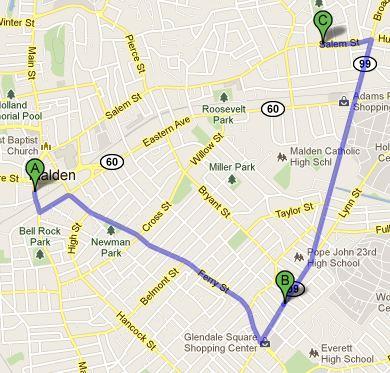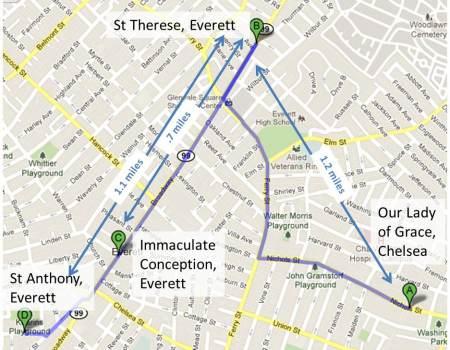Boston Catholic Insider
July 21, 2011
http://bostoncatholicinsider.wordpress.com/author/bostoncatholicinsider/
There was yet another article in the Boston Globe Tuesday sympathetic to the vigilers occupying churches in the Boston archdiocese–this one, about St. Therese in Everett. As we learned last week, the church building will stay open as an oratory of nearby St. Anthony in Everett. BCI just does not entirely get what the protesters are still after, and must be missing something here.
Entitled, "Vigilers resist church's conversion plan," here are some excerpts from the Globe article:
EVERETT – Catholics who have occupied St. Therese Church for seven years vowed last night to continue their vigil, despite a plan by the Archdiocese of Boston to convert it to a chapel for use by the Brazilian Catholic community.
"We are still in vigil and will maintain our vigil," said Joan Shepard, a vigil leader, standing behind an altar. "We feel this decision is a mistake… .. It's very disrespectful."
"Aren't we all children of God?" asked Gloria Young, one of a dozen parishioners seated in pews. "We've been sitting here for seven years, and for what? So that someone else can use it?"…
A dozen supporters of the vigil met last night in the hot, stuffy church to plot their resistance to the archdiocese's new use for St. Therese.
The church on Broadway is slated to become St. Therese Oratory, part of St. Anthony Parish of Everett. Masses will be offered in Portuguese, to accommodate a growing number of Brazilian immigrants in this city north of Boston seeking to worship in their own language.
"The Brazilian population is a very significant part of the growth of the Catholic Church," said Terrence C. Donilon, the archdiocesan spokesman. "This is going to address their needs long term."…
Parishioners at St. Therese said they would not leave the church. Some have spent dozens of nights in the church, even after the archdiocese shut off heat and water after a boiler broke in 2009.
"This just doesn't seem right," said Carol Tumasz, 53, who moved into the church for a period. "What about the rest of the people?"
Shepard said she received a phone call from the archdiocese last Thursday, but she is angry they did not receive a letter from O'Malley.
"I have received no official word from the cardinal's office," she said. "Our families built this church, and we saved it from destruction. It's unthinkable that we will not be able to worship here."
Donilon defended O'Malley and said all Catholics will be welcome at St. Therese Oratory. "I understand the people are sad, but the cardinal has been very patient… . We think this is a good new use for St. Therese."
A church building that, as of about a year ago, was doomed to closure and sale was saved. Yet the dozen vigilers are going to continue occupying the space because they are not completely getting their way, and a different Catholic community will use the building who didn't occupy it for seven years? Does anyone else besides BCI see some of the quotes in the Globe as just a bit whiney?
Sadly, the Globe reporting still fails to ask some key questions of the people occupying the building and their motives. Beyond that, the history once again validates the diocesan mismanagement we mentioned in our last post.
For example, who exactly are the people occupying the building? A commenter on this discussion about the closing from 2008 identified as "55 years in Everett" said:
"The people holding the vigil are only a handful and the dollar a week they put in the box won't pay the bills, that's for sure. I know people that go down there everyday and sit for two hours at a time and they are not even Catholic! They never went to the church until the vigil started, it's just a little social gathering for them, and this I know for fact."
Above and beyond this question, why is the fact that there are 5 other Catholic parishes within a mile and a half away never mentioned? If you look at the map below, Immaculate Conception in Everett is less than 3/4 of a mile away, just down Broadway, from St. Therese in Everett. St. Anthony in Everett is 1.1 miles away, and our Lady of Grace in Chelsea is 1.2 miles away.
 |
Two churches in nearby Malden, Sacred Heart (A, in the picture below), and St. Joseph (C in the picture), are also within 1.5 miles away from St. Therese (B).
 |
BCI is curious as to why these 12 people occupying the church would find it so difficult to drive, take public transportation, or get a ride from a neighbor or friend to one of these 5 churches? Are they even attending Mass on Sundays in an open parish today, or have they been neglecting their Sunday obligation these past 7 years?
Then we have the question of the mismanagement. As has been said before, for years the archdiocese has really made no effort whatsoever to end the occupancies. In most parishes, that could have at least saved money on the added costs of maintaining the buildings to residential standards while the parish closings were under appeal. This March 2009 article confirms the failure of the archdiocese to even try to reclaim the buildings from the protesters:
Similar vigils have taken place elsewhere in the U.S. — including New York City, Kansas and Ohio — but not every diocese has tolerated the dissent. In New Orleans in January, church leaders called in police after two months, and they broke down a door and arrested two protesters as they cleared out two churches.
Sister Marian Batho, an archdiocesan liaison to the Boston area's occupied churches, said O'Malley wouldn't consider that approach: "Cardinal Sean is a man of peace."
O'Malley wants to wait until all the appeals are played out, possibly this spring, and only then approach those refusing to leave, [Sr. Marian] Batho said. "We would hope we could resolve this in a respectful way," she said.
The vigils are billed as 24 hour-a-day affairs, but some parishioners acknowledge there have been short gaps when no one was occupying a building. The archdiocese does not have the buildings under surveillance, and had no one there to reclaim the churches.
Not even trying to (peacefully) reclaim the churches over the past 7 years when the opportunity has been readily available just seems like mismanagement to BCI. Let the appeals keep running, but to allow people to take up residence in the churches for 7 years does not make sense and suggests weak leadership from on top.
BCI agrees with commenter "Serviam" that Catholic churches are sacred worship spaces that are not just a simple commodity to be bought and sold at will. It is the place Catholics traditionally expect encountered our Eucharistic Lord both within and outside the Holy Sacrifice of the Mass. They were often built and supported with the labor and financial contributions of immigrants. Catholic churches carry important memories of baptisms, first Communions, confirmation, weddings, funerals. The decision to close a church should never be taken lightly and there must be grave reasons to close a church.
But what should happen when most–if not all of the people–who carry these memories and attachments to a particular church have accepted the decision the church had to close for grave reasons and have moved on to another Catholic parish, and what remain are protesters who never had much of an affiliation with the church? Or, in the case of St. Therese, the building was spared, but the protesters are still upset because they cannot have it entirely their way.
Is there something about this that the Globe and archdiocese get, but which BCI is missing?
Any original material on these pages is copyright © BishopAccountability.org 2004. Reproduce freely with attribution.